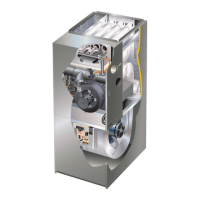Normal Operation: When hot water
is
being used, cold
water enters the bottom of the heater (either bottom feed or
by diptube),
and
the bottom element will begin to heat the
cold water. If
lots
of
hot water has been used, the upper
thermostat will take priority
and
the top portion of the heater
will
be
heated. Once heated, the thermostat will flip down to
the lower thermostat to heat the lower portion.
.AI""""""
,pply
'pqwe
havj",erifie
pl~e""
Ie
:Tb
ensur~
wat
Cln(f:ri:th
fr()~y
fa
",,e:,,L;'jLry·'
::(3)m
inut~
"":';:",.
'--;i-C
....
<:':.".::::,,,:,,
Filling
the
Tank
NOTE: When filling, avoid water spillage.
Do
not allow the
insulation of the heater to get wet
as
water can cause elec-
trical malfunction.
1.
Close the drain valve, and then open a hot water faucet.
2.
Open the cold water supply valve.
3.
When water
runs
out of the hot faucet, the tank
is
full.
4.
Check the system for leaks.
Draining
the
Tank
(completely)
If
the
power
is
to
be
turned off during the cold season
and
the tank is exposed to freezing temperatures, the water
heater must
be
drained. Water will expand when it freezes
and
can damage the heater.
Completely drain as follows:
1.
Make sure the electrical supply to the water heater
is
"OFF".
2.
Turn off cold water supply.
3.
Connect a garden hose to the
end
of the drain valve
and
direct this to a point lower than the heater.
4.
Open a hot water faucet.
5.
Open the drain valve
on
the heater - drain, keeping the
drain valve
open
during the shutdown period.
6.
To
refill the heater, see "Filling the
Tank"
section.
Check Here
Installation
Check
List
1.
Are the fuse
and
wire sizes correct? 0
2.
Is
the certified relief valve installed? 0
3.
Are you sure that
in
case
of
water leakage, the 0
building, furniture, carpeting or other property
will not
be
damaged?
4.
Has the relief valve been piped to a suitable
o
drain point?
5.
Is
the relief valve discharge unobstructed?
o
6.
Is
the heater completely filled with water?
o
7.
Is
the cold supply valve open?
o
If
the answers
to
the
above are
"Yes",
turn
on
the
power and enjoy all
the
hot
water
you
need, all
the
time.
Temperature
Adjustment
Thermostats are factory set at 140°F (60°C) (Canada),
120°F (49°C) (U.S.A.). The thermostats operate automati-
cally.
They can
be
adjusted to provide warmer or cooler
water temperature. Set both thermostats to the SAME set-
ting (if applicable).
If water temperature adjustment
is
required:
1.
Turn
the electrical supply to the water heater "OFF".
2.
Remove the access door(s) and insulation pad(s).
3.
Check with a voltage tester at terminal 1
and
3 of the limit
control that power
is
indeed "OFF".
4.
Adjust the thermostat(s) to the water temperature
desired (if a two-thermostat system exists, set both ther-
mostats at the same temperature).
5.
Ensure insulation
pad
is
in
the door cavity. Replace
access door(s).
6.
Turn
the electrical supply to the water heater "ON".
Temperature
Limit
Control
For safety, a non-adjustable high limit temperature switch
will shut off the power when excessive water temperatures
are reached. This switch must
be
re-set manually. See
''Trouble-Shooting'' section.
Temperature
&
Pressure
Relief
Valve
Manually operate the temperature and pressure relief valve
at least once a year to make sure it
is
working properly and
that there are
no
blockages.
To
prevent water damage, the
valve must be properly connected to a discharge line that
terminates at
an
adequate drain. Standing clear
of
the
outlet
(discharged
water
may be hot), slowly lift and
release the lever handle on the temperature and pressure
relief valve (see Figure
3)
to allow the valve to operate freely
and
return to
its
closed position. If the valve fails to com-
pletely reset and continues to release water, immediately
turn "OFF" the electrical supply to the tank, and close the
cold water supply valve and call a qualified service techni-
-6-

